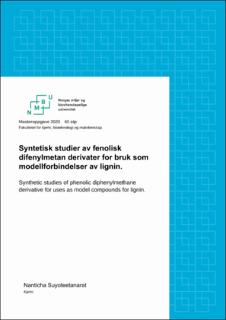Syntetisk studier av fenolisk difenylmetan derivater for bruk som modellforbindelser av lignin
Master thesis
Permanent lenke
https://hdl.handle.net/11250/2690039Utgivelsesdato
2020Metadata
Vis full innførselSamlinger
- Master's theses (KBM) [890]
Sammendrag
Kondensasjonsreaksjon av lignin fragmenter er et av problemer for effektiv utnyttelse av lignin. Denne typen reaksjonen ble tidligere studert av Shimada et al[1] der enkelt difenylmetan analog var syntetisert fra blant annet 3,4-dimetoksibenzyl alkohol, 3,4,5-trimetoksiyl alkohol, 2,6- dimetoksi-4-metylfenol og 2-metoksi-4-metylfenol, for å bruke som modell forbindelse av lignin fragmentene.
I denne oppgaven ble fenolisk difenylmetan derivater framstilt. Totalt ble det syntetisert åtte forbindelser, fire av dem var rapportert av Shimada et al[1] , og fire er nye forbindelser. Disse nye forbindelsenes mangler HRMS-data og trenger en endelig struktur bekreftelse. Syntesen strategien var basert på arbeidet til Shimada, og mikrobølgeovn ble benyttet som rektor fremfor konvensjonelloppvarming.
I meste parten ble det dannet av biproduktet og rå-produktene av kompleks. Syntesen av 3-(3,4- dimetoksibenzyl)-2,6-dimetoksi-4-metylfenol, og 2,6-dimetoksi-4-metyl-3-(3,4,5- trimetoksibenzyl)fenol gav utbytte på mindre enn 20%. Alle andre reaksjonene gav en god del bedre utbyttet (fra 40%). Konvensjonell oppvarmingsmetoden ble også utprøvd en del tilfelle reaksjon for å sammenligne med bruk av MAOS. The condensation reaction of lignin fragments during degradation has been reported as one of the problems of lignin's valorization. This type of reaction was earlier studied by Shimada et al[1] , using 3,4-dimethoxybenzyl alcohol, 3,4,5-trimethoxybenzyl alcohol, 2,6-dimethoxy-4- metylphenol, and 2-methoxy-4-methylpheol for the synthesis of diphenylmethane analogs, to be used as the model compounds.
In this thesis, the derivatives of phenolic diphenylmethane have been synthesized. Eight compounds were made, used Microwave-Assisted Organic Synthesis. Four of them were reported by Shimada, and four are new. These four new compounds are still lacking HMRS-data, and structures need to be identified.
Byproducts were recognized in most cases, giving complex raw products. The synthesis of 3- (3,4-dimethoxybenzyl)-2,6-dimethoxy-4-methylphenol and 2,6-dimethoxy-4-methyl-3-(3,4,5- trimethoxybenzyl)phenol yielded low yield (least than 20%), while the other reactions yielded about 40% of products.
The conventional heating method was also performed on some reaction to compare the reaction's effectivity.

